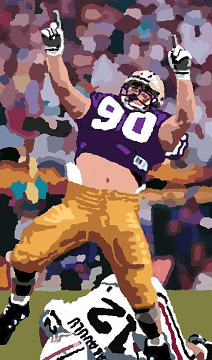1) Miami-Florida 12-0
2) Washington 12-0
3) Penn State 11-2
4) Florida State 11-2
5) Alabama 11-1
6) Michigan 10-2
7) Florida 10-2
8) California 10-2
9) East Carolina 11-1
10) Iowa 10-1-1
11) Syracuse 10-2
12) Texas A&M 10-2
13) Notre Dame 10-3
14) Tennessee 9-3
15) Nebraska 9-2-1
16) Oklahoma 9-3
17) Georgia 9-3
18) Clemson 9-2-1
19) UCLA 9-3
20) Colorado 8-3-1
21) Tulsa 10-2
22) Stanford 8-4
23) Brigham Young 8-3-2
24) North Carolina State 9-3
25) Air Force 10-3
For the third time (the others being 2003 and 1997), we have a problem at the top of the AP poll. This time it's 12-0 Miami finishing at #1 ahead of 12-0 Washington, albeit by a mere 4 votes (Washington took #1 in the coaches' poll by twice that margin).
The problem for Miami boils down to just one game: their 19-14 win at 4-7 Boston College on November 23rd. If not for that poor performance, Miami would be a valid option for #1. Washington would still be the better choice, in my opinion, but the point is that it would come down to that: opinion.
Of course, Miami finishing #1 in the AP poll comes down to opinion as it is, but it shouldn't. It should come down to facts, and the facts line up for Washington. Each team played 4 ranked opponents and 1 nearly ranked opponent, but Washington won their games by an average of 31.7 points per game, while Miami won theirs by an average of 19.3
Washington's only close game was 24-17 at #8 California. Miami had 3 close games: 26-20 against #3 Penn State, 17-16 at #4 Florida State, and most critically, the aforementioned 19-14 win at 4-7 Boston College late in the season.
All of which begs the question, Why did Miami end up #1 in the AP poll in the first place?

The best player on the best team in Washington's history was defensive tackle Steve Emtman, winner of the Outland and Lombardi trophies, 4th in the Heisman vote, and the first player taken in the next NFL draft.
